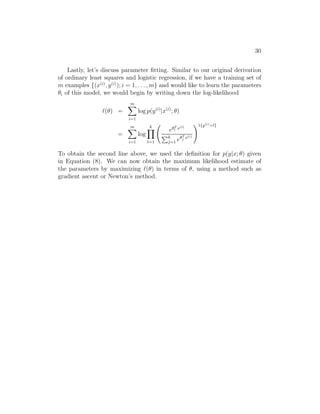This document summarizes Andrew Ng's lecture notes on supervised learning and linear regression. It begins with examples of supervised learning problems like predicting housing prices from living area size. It introduces key concepts like training examples, features, hypotheses, and cost functions. It then describes using linear regression to predict prices from area and bedrooms. Gradient descent and stochastic gradient descent are introduced as algorithms to minimize the cost function. Finally, it discusses an alternative approach using the normal equations to explicitly minimize the cost function without iteration.
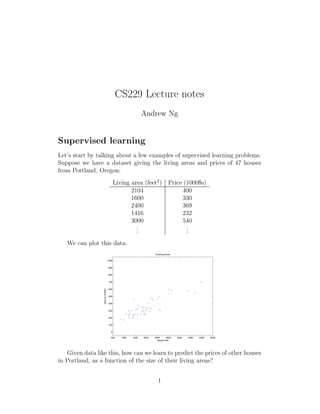
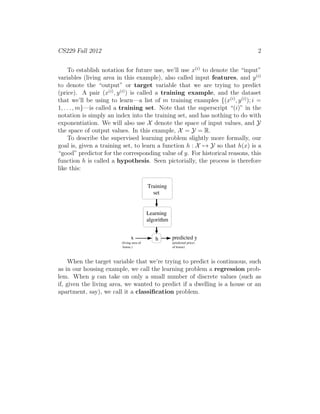
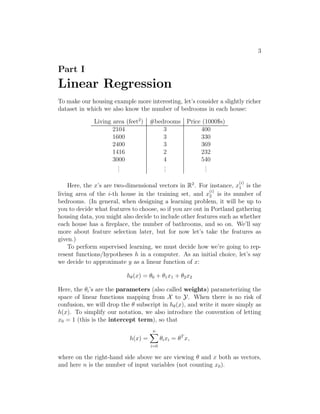
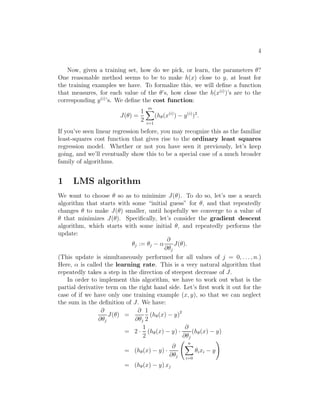
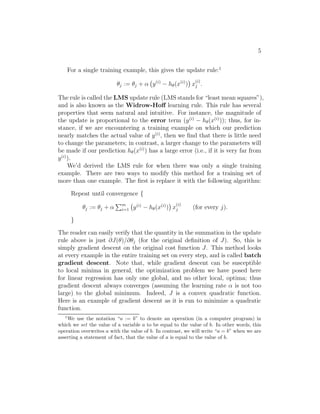
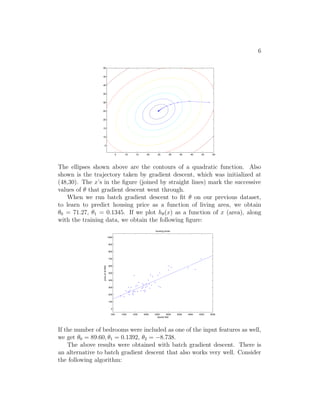
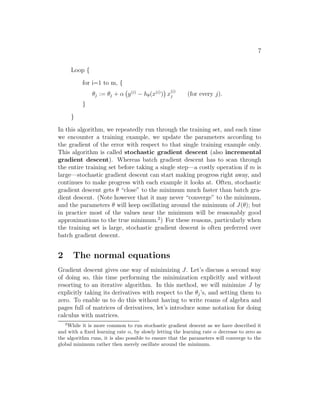


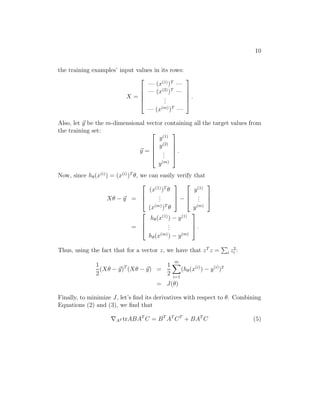
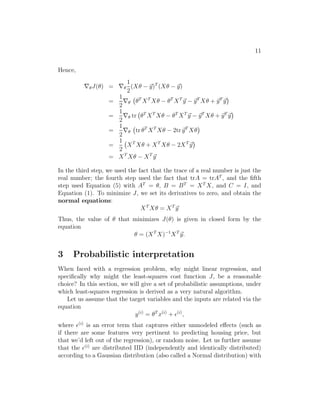
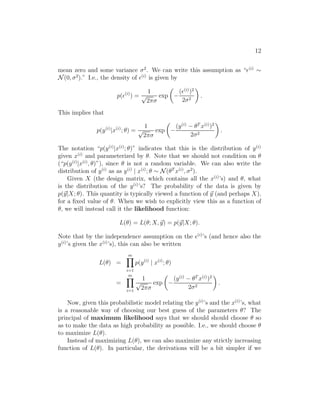

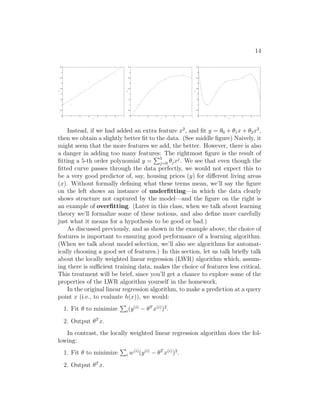

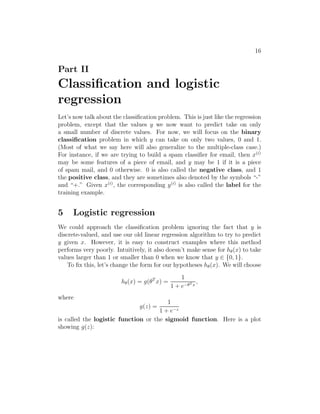
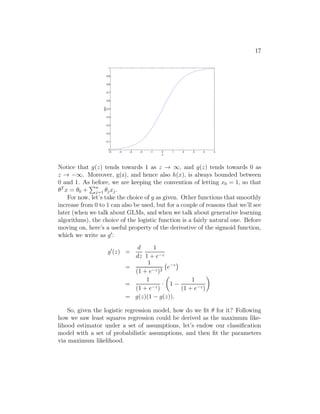
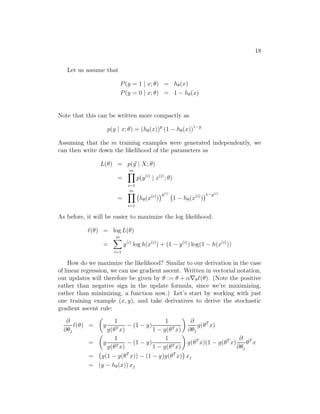
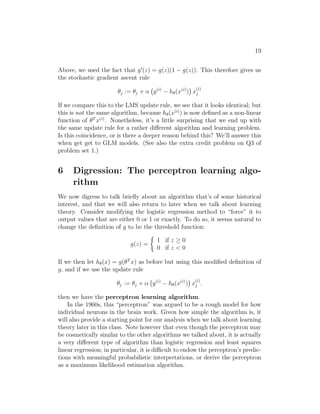
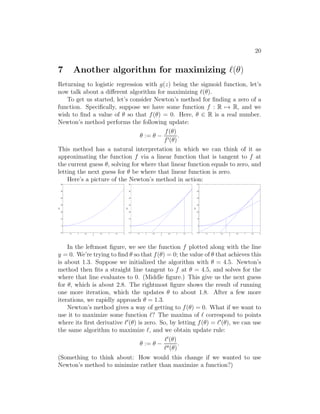
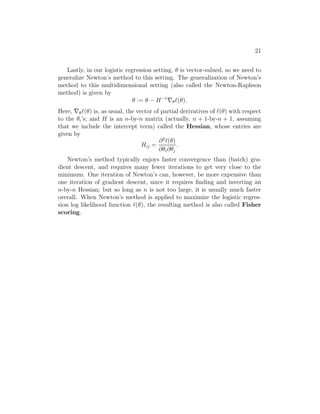
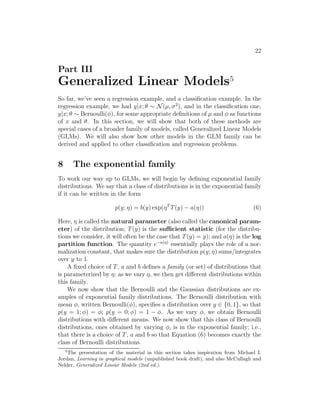
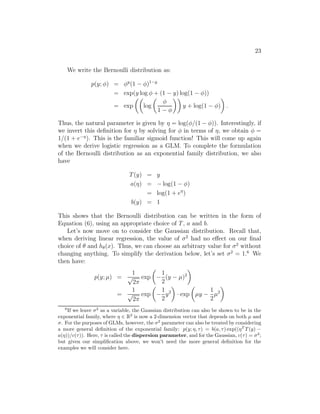
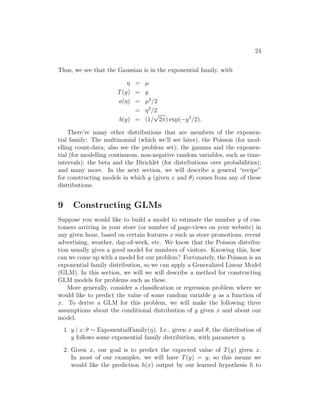
![25
satisfy h(x) = E[y|x]. (Note that this assumption is satisfied in the
choices for hθ(x) for both logistic regression and linear regression. For
instance, in logistic regression, we had hθ(x) = p(y = 1|x; θ) = 0 · p(y =
0|x; θ) + 1 · p(y = 1|x; θ) = E[y|x; θ].)
3. The natural parameter η and the inputs x are related linearly: η = θT
x.
(Or, if η is vector-valued, then ηi = θT
i x.)
The third of these assumptions might seem the least well justified of
the above, and it might be better thought of as a “design choice” in our
recipe for designing GLMs, rather than as an assumption per se. These
three assumptions/design choices will allow us to derive a very elegant class
of learning algorithms, namely GLMs, that have many desirable properties
such as ease of learning. Furthermore, the resulting models are often very
effective for modelling different types of distributions over y; for example, we
will shortly show that both logistic regression and ordinary least squares can
both be derived as GLMs.
9.1 Ordinary Least Squares
To show that ordinary least squares is a special case of the GLM family
of models, consider the setting where the target variable y (also called the
response variable in GLM terminology) is continuous, and we model the
conditional distribution of y given x as as a Gaussian N (µ, σ2
). (Here, µ
may depend x.) So, we let the ExponentialFamily(η) distribution above be
the Gaussian distribution. As we saw previously, in the formulation of the
Gaussian as an exponential family distribution, we had µ = η. So, we have
hθ(x) = E[y|x; θ]
= µ
= η
= θT
x.
The first equality follows from Assumption 2, above; the second equality
follows from the fact that y|x; θ ∼ N (µ, σ2
), and so its expected value is given
by µ; the third equality follows from Assumption 1 (and our earlier derivation
showing that µ = η in the formulation of the Gaussian as an exponential
family distribution); and the last equality follows from Assumption 3.](https://image.slidesharecdn.com/cs229-notes1-170112040003/85/CS229-Machine-Learning-Lecture-Notes-25-320.jpg)
![26
9.2 Logistic Regression
We now consider logistic regression. Here we are interested in binary classifi-
cation, so y ∈ {0, 1}. Given that y is binary-valued, it therefore seems natural
to choose the Bernoulli family of distributions to model the conditional dis-
tribution of y given x. In our formulation of the Bernoulli distribution as
an exponential family distribution, we had φ = 1/(1 + e−η
). Furthermore,
note that if y|x; θ ∼ Bernoulli(φ), then E[y|x; θ] = φ. So, following a similar
derivation as the one for ordinary least squares, we get:
hθ(x) = E[y|x; θ]
= φ
= 1/(1 + e−η
)
= 1/(1 + e−θT x
)
So, this gives us hypothesis functions of the form hθ(x) = 1/(1 + e−θT x
). If
you are previously wondering how we came up with the form of the logistic
function 1/(1 + e−z
), this gives one answer: Once we assume that y condi-
tioned on x is Bernoulli, it arises as a consequence of the definition of GLMs
and exponential family distributions.
To introduce a little more terminology, the function g giving the distri-
bution’s mean as a function of the natural parameter (g(η) = E[T(y); η])
is called the canonical response function. Its inverse, g−1
, is called the
canonical link function. Thus, the canonical response function for the
Gaussian family is just the identify function; and the canonical response
function for the Bernoulli is the logistic function.7
9.3 Softmax Regression
Let’s look at one more example of a GLM. Consider a classification problem
in which the response variable y can take on any one of k values, so y ∈
{1, 2, . . . , k}. For example, rather than classifying email into the two classes
spam or not-spam—which would have been a binary classification problem—
we might want to classify it into three classes, such as spam, personal mail,
and work-related mail. The response variable is still discrete, but can now
take on more than two values. We will thus model it as distributed according
to a multinomial distribution.
7
Many texts use g to denote the link function, and g−1
to denote the response function;
but the notation we’re using here, inherited from the early machine learning literature,
will be more consistent with the notation used in the rest of the class.](https://image.slidesharecdn.com/cs229-notes1-170112040003/85/CS229-Machine-Learning-Lecture-Notes-26-320.jpg)
![27
Let’s derive a GLM for modelling this type of multinomial data. To do
so, we will begin by expressing the multinomial as an exponential family
distribution.
To parameterize a multinomial over k possible outcomes, one could use
k parameters φ1, . . . , φk specifying the probability of each of the outcomes.
However, these parameters would be redundant, or more formally, they would
not be independent (since knowing any k − 1 of the φi’s uniquely determines
the last one, as they must satisfy k
i=1 φi = 1). So, we will instead pa-
rameterize the multinomial with only k − 1 parameters, φ1, . . . , φk−1, where
φi = p(y = i; φ), and p(y = k; φ) = 1 − k−1
i=1 φi. For notational convenience,
we will also let φk = 1 − k−1
i=1 φi, but we should keep in mind that this is
not a parameter, and that it is fully specified by φ1, . . . , φk−1.
To express the multinomial as an exponential family distribution, we will
define T(y) ∈ Rk−1
as follows:
T (1) =
⎡
⎢
⎢
⎢
⎢
⎢
⎣
1
0
0
...
0
⎤
⎥
⎥
⎥
⎥
⎥
⎦
, T (2) =
⎡
⎢
⎢
⎢
⎢
⎢
⎣
0
1
0
...
0
⎤
⎥
⎥
⎥
⎥
⎥
⎦
, T (3) =
⎡
⎢
⎢
⎢
⎢
⎢
⎣
0
0
1
...
0
⎤
⎥
⎥
⎥
⎥
⎥
⎦
, · · · , T (k−1) =
⎡
⎢
⎢
⎢
⎢
⎢
⎣
0
0
0
...
1
⎤
⎥
⎥
⎥
⎥
⎥
⎦
, T (k) =
⎡
⎢
⎢
⎢
⎢
⎢
⎣
0
0
0
...
0
⎤
⎥
⎥
⎥
⎥
⎥
⎦
,
Unlike our previous examples, here we do not have T(y) = y; also, T(y) is
now a k − 1 dimensional vector, rather than a real number. We will write
(T(y))i to denote the i-th element of the vector T(y).
We introduce one more very useful piece of notation. An indicator func-
tion 1{·} takes on a value of 1 if its argument is true, and 0 otherwise
(1{True} = 1, 1{False} = 0). For example, 1{2 = 3} = 0, and 1{3 =
5 − 2} = 1. So, we can also write the relationship between T(y) and y as
(T(y))i = 1{y = i}. (Before you continue reading, please make sure you un-
derstand why this is true!) Further, we have that E[(T(y))i] = P(y = i) = φi.
We are now ready to show that the multinomial is a member of the](https://image.slidesharecdn.com/cs229-notes1-170112040003/85/CS229-Machine-Learning-Lecture-Notes-27-320.jpg)
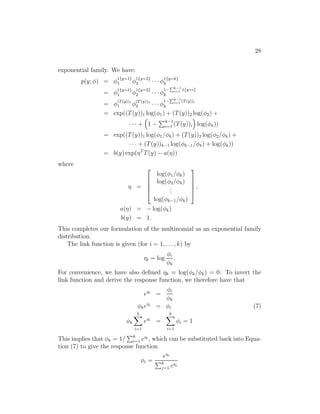
![29
This function mapping from the η’s to the φ’s is called the softmax function.
To complete our model, we use Assumption 3, given earlier, that the ηi’s
are linearly related to the x’s. So, have ηi = θT
i x (for i = 1, . . . , k − 1),
where θ1, . . . , θk−1 ∈ Rn+1
are the parameters of our model. For notational
convenience, we can also define θk = 0, so that ηk = θT
k x = 0, as given
previously. Hence, our model assumes that the conditional distribution of y
given x is given by
p(y = i|x; θ) = φi
=
eηi
k
j=1 eηj
=
eθT
i x
k
j=1 eθT
j x
(8)
This model, which applies to classification problems where y ∈ {1, . . . , k}, is
called softmax regression. It is a generalization of logistic regression.
Our hypothesis will output
hθ(x) = E[T(y)|x; θ]
= E
⎡
⎢
⎢
⎢
⎣
1{y = 1}
1{y = 2}
...
1{y = k − 1}
x; θ
⎤
⎥
⎥
⎥
⎦
=
⎡
⎢
⎢
⎢
⎣
φ1
φ2
...
φk−1
⎤
⎥
⎥
⎥
⎦
=
⎡
⎢
⎢
⎢
⎢
⎢
⎢
⎣
exp(θT
1 x)
k
j=1 exp(θT
j x)
exp(θT
2 x)
k
j=1 exp(θT
j x)
...
exp(θT
k−1x)
k
j=1 exp(θT
j x)
⎤
⎥
⎥
⎥
⎥
⎥
⎥
⎦
.
In other words, our hypothesis will output the estimated probability that
p(y = i|x; θ), for every value of i = 1, . . . , k. (Even though hθ(x) as defined
above is only k − 1 dimensional, clearly p(y = k|x; θ) can be obtained as
1 − k−1
i=1 φi.)](https://image.slidesharecdn.com/cs229-notes1-170112040003/85/CS229-Machine-Learning-Lecture-Notes-29-320.jpg)
